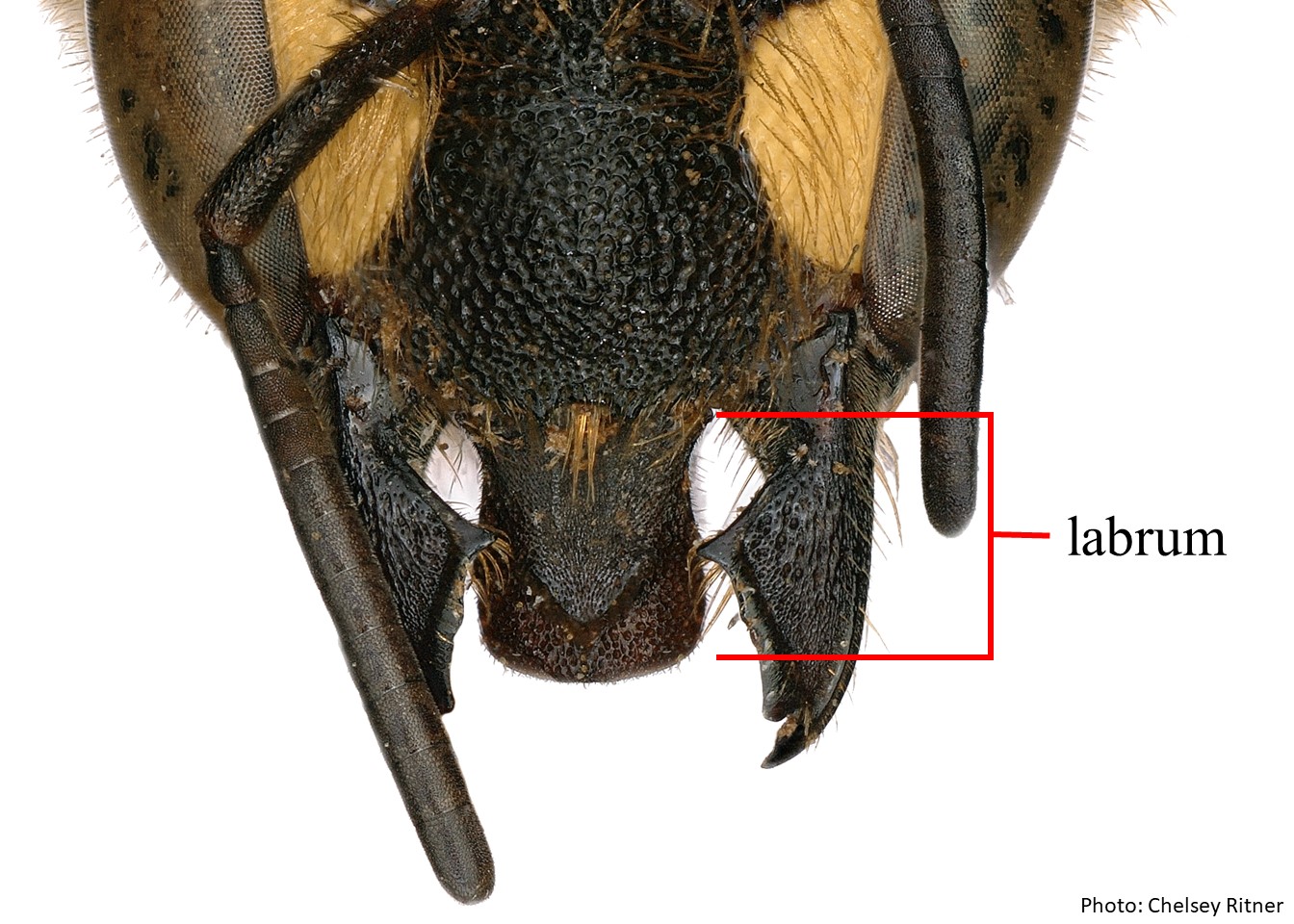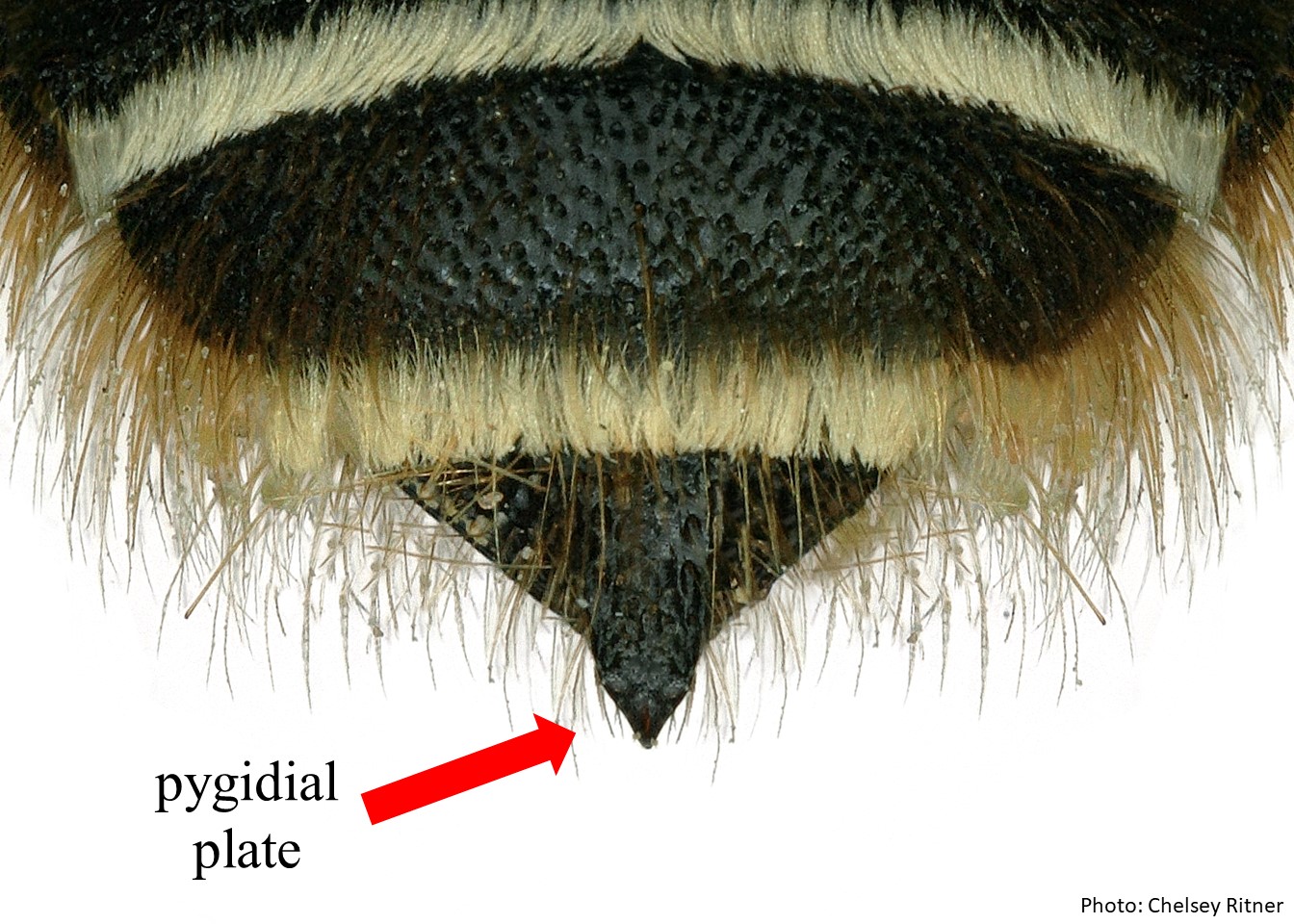Family: Megachilidae
Subfamily: Lithurginae
Tribe: Lithurgini
Genus: Lithurgus Berthold, 1827
Subgenera: none
Common name: none
Lithurgus has a slightly elongated and flattened abdomen (Michener 2007Michener 2007:
Michener, C.D. 2007. The Bees of the World (2nd ed.). Johns Hopkins University Press, Baltimore and London, 953 pp.). They are black with pale yellow or white bandsbands:
usually referring to bands of hair or bands of color that traverse across an abdominal segment
of hair on their tergaterga:
the segments on the top side of the abdomen, often abbreviated when referring to a specific segment to T1, T2, T3, T4, T5, T6, or T7 . They range in body length from 8–19 mm (Michener 2007Michener 2007:
. They range in body length from 8–19 mm (Michener 2007Michener 2007:
Michener, C.D. 2007. The Bees of the World (2nd ed.). Johns Hopkins University Press, Baltimore and London, 953 pp.).
Lithurgus contains 33 species (Gonzalez et al. 2013Gonzalez et al. 2013:
Gonzalez, V.H., M.S. Engel, and T. Griswold. 2013. The lithurgine bees of Australia (Hymenoptera: Megachilidae), with a note on Megachile rotundipennis . Journal of Melittology 11: 1ndash;19.); 2 species are known to occur in the U.S. (Wilson and Carril 2016Wilson and Carril 2016:
Wilson, J.S. and O.M. Carril. 2016. The Bees in Your Backyard: A Guide to North Americarsquo;s Bees. Princeton University Press, Princeton and Oxford, 288 pp.).
(modified from Michener 2007Michener 2007:
Michener, C.D. 2007. The Bees of the World (2nd ed.). Johns Hopkins University Press, Baltimore and London, 953 pp. unless otherwise stated)
 about as long as clypeusclypeus:
about as long as clypeusclypeus: present.
present. .
.Lithurgus looks similar to some Megachile and Austrothurgus but can be distinguished by the characters listed above (Michener 2007Michener 2007:
Michener, C.D. 2007. The Bees of the World (2nd ed.). Johns Hopkins University Press, Baltimore and London, 953 pp.).
L. chrysurus is adventive to the U.S. It was accidentally introduced in the early to mid-1970s from the western Mediterranean (Roberts 1978Roberts 1978:
Roberts, R.B. 1978. The nesting biology, behavior, and immature stages of Lithurge chrysurus , an adventitious wood-boring bee in New Jersey (Hymenoptera: Megachilidae). Journal of the Kansas Entomological Society 51: 735ndash;745.). It is currently known to be established in a limited area of Pennsylvania and New Jersey, although at apparently small numbers (Russo 2016Russo 2016:
Russo, L. 2016. Positive and negative impacts of non-native bee species around the world. Insects 7: 69.).
L. scabrosus was introduced to Hawaii from the South Pacific sometime before 1907; it probably arrived with Europeans (Snelling 2003Snelling 2003:
Snelling, R.R., 2003. Bees of the Hawaiian Islands, exclusive of Hylaeus ( Nesoprosopis ) (Hymenoptera: Apoidea). Journal of the Kansas Entomological Society 76 (2): 342ndash;356.; Russo 2016Russo 2016:
Russo, L. 2016. Positive and negative impacts of non-native bee species around the world. Insects 7: 69.). It is known from Kauai and Oahu, and frequently visits Hibiscus flowers (Snelling 2003Snelling 2003:
Snelling, R.R., 2003. Bees of the Hawaiian Islands, exclusive of Hylaeus ( Nesoprosopis ) (Hymenoptera: Apoidea). Journal of the Kansas Entomological Society 76 (2): 342ndash;356.).
Lithurgus tends to be specialized on either Malvaceae or Asteraceae (Wilson and Carril 2016Wilson and Carril 2016:
Wilson, J.S. and O.M. Carril. 2016. The Bees in Your Backyard: A Guide to North Americarsquo;s Bees. Princeton University Press, Princeton and Oxford, 288 pp.). In the U.S., L. chrysurus is specialized on Centaurea (Wilson and Carril 2016Wilson and Carril 2016:
Wilson, J.S. and O.M. Carril. 2016. The Bees in Your Backyard: A Guide to North Americarsquo;s Bees. Princeton University Press, Princeton and Oxford, 288 pp.), and it seems to prefer the noxious invasive spotted knapweed (C. stoebe micranthos), which is also from the Mediterranean (Roberts 1978Roberts 1978:
Roberts, R.B. 1978. The nesting biology, behavior, and immature stages of Lithurge chrysurus , an adventitious wood-boring bee in New Jersey (Hymenoptera: Megachilidae). Journal of the Kansas Entomological Society 51: 735ndash;745.). The disparity between the widespread occurrence of the host weed, which has already spread throughout the western and northern U.S., and the currently limited range of L. chrysurus is interesting.
Lithurgus is a solitary, although often very gregarious, genus of wood-boring bees. They burrow into and nest inside dead rotting wood as well as firm nondegraded hardwood, firewood, man-made wood structures, or wood-based materials following the wood grain (Roberts 1978Roberts 1978:
Roberts, R.B. 1978. The nesting biology, behavior, and immature stages of Lithurge chrysurus , an adventitious wood-boring bee in New Jersey (Hymenoptera: Megachilidae). Journal of the Kansas Entomological Society 51: 735ndash;745.; Rust et al. 2004Rust et al. 2004:
Rust, R.W., G. Camon, J.T. Grossa, and B.E. Vaissiegrave;re. 2004. Nesting biology and foraging ecology of the wood-boring bee Lithurgus chrysurus (Hymenoptera: Megachilidae). Journal of the Kansas Entomological Society 77: 269ndash;279.; Rozen and Wyman 2013Rozen and Wyman 2013:
Rozen Jr., J.G. and E.S. Wyman. 2013. Larval development and nesting biology of the adventive wood-boring bee Lithurgus (L.) chrysurus Fonscolombe (Hymenoptera: Megachilidae: Lithurgini). American Museum Novitates 3774: 1ndash;20.; Rozen and Wyman 2014Rozen and Wyman 2014:
Rozen Jr., J.G. and E.S. Wyman. 2014. Early nesting biology of the wood-boring adventive bee, Lithurgus chrysurus Fonscolombe (Apoidea: Megachilidae: Lithurginae). American Museum Novitates 3804: 1ndash;12.). One elongated cell may contain multiple provisions with brood contained one after another in a linear series. Wood materials are sometimes used to partition the nest into multiple separate cells (Roberts 1978Roberts 1978:
Roberts, R.B. 1978. The nesting biology, behavior, and immature stages of Lithurge chrysurus , an adventitious wood-boring bee in New Jersey (Hymenoptera: Megachilidae). Journal of the Kansas Entomological Society 51: 735ndash;745.; Rust et al. 2004Rust et al. 2004:
Rust, R.W., G. Camon, J.T. Grossa, and B.E. Vaissiegrave;re. 2004. Nesting biology and foraging ecology of the wood-boring bee Lithurgus chrysurus (Hymenoptera: Megachilidae). Journal of the Kansas Entomological Society 77: 269ndash;279.). The habit of burrowing into wooden structures like crates, fiber composite building materials, beams, and timbers increases both the likelihood of being transported by people as well as their potential economic destructiveness (Rust et al. 2004Rust et al. 2004:
Rust, R.W., G. Camon, J.T. Grossa, and B.E. Vaissiegrave;re. 2004. Nesting biology and foraging ecology of the wood-boring bee Lithurgus chrysurus (Hymenoptera: Megachilidae). Journal of the Kansas Entomological Society 77: 269ndash;279.; Rozen and Wyman 2014Rozen and Wyman 2014:
Rozen Jr., J.G. and E.S. Wyman. 2014. Early nesting biology of the wood-boring adventive bee, Lithurgus chrysurus Fonscolombe (Apoidea: Megachilidae: Lithurginae). American Museum Novitates 3804: 1ndash;12.).
Lithurgus occurs natively in various places throughout the Old WorldOld World:
the part of the world that was known before the discovery of the Americas, comprised of Europe, Asia, and Africa; the Eastern Hemisphere
. In the U.S., it is represented by two introduced species: L. chrysurus and L. scabrosus (Michener 2007Michener 2007:
Michener, C.D. 2007. The Bees of the World (2nd ed.). Johns Hopkins University Press, Baltimore and London, 953 pp.). One species, Lithurgus huberi, can be found in South America.
Distribution map generated by Discover Life -- click on map for details, credits, and terms of use.
Gonzalez, V.H., M.S. Engel, and T.L. Griswold. 2013. The lithurgine bees of Australia (Hymenoptera: Megachilidae), with a note on Megachile rotundipennis. Journal of Melittology 11: 1-19.
Michener, C.D. 2007. The Bees of the World (2nd ed.). Johns Hopkins University Press, Baltimore and London, 953 pp.
Roberts, R.B. 1978. The nesting biology, behavior, and immature stages of Lithurge chrysurus, an adventitious wood-boring bee in New Jersey (Hymenoptera: Megachilidae). Journal of the Kansas Entomological Society 51:735-745.
Rozen Jr., J.G. and E.S. Wyman. 2013. Larval development and nesting biology of the adventive wood-boring bee Lithurgus (L.) chrysurus Fonscolombe (Hymenoptera: Megachilidae: Lithurgini). American Museum Novitates 3774:1-20.
Rozen Jr., J.G. and E.S. Wyman. 2014. Early nesting biology of the wood-boring adventive bee, Lithurgus chrysurus Fonscolombe (Apoidea: Megachilidae: Lithurginae). American Museum Novitates 3804:1-12.
Russo, L. 2016. Positive and negative impacts of non-native bee species around the world. Insects 7: 69.
Rust, R.W., C. Geneviève, J.T. Grossa, and B.E. Vaissière. 2004. Nesting biology and foraging ecology of the wood-boring bee Lithurgus chrysurus (Hymenoptera: Megachilidae). Journal of the Kansas Entomological Society 77:269-279.
Snelling, R.R., 2003. Bees of the Hawaiian Islands, exclusive of Hylaeus (Nesoprosopis) (Hymenoptera: Apoidea). Journal of the Kansas Entomological Society 76(2): 342-356.
Wilson, J.S. and O.M. Carril. 2016. The Bees in Your Backyard: A Guide to North America’s Bees. Princeton University Press, Princeton and Oxford, 288 pp.